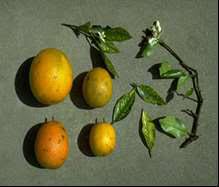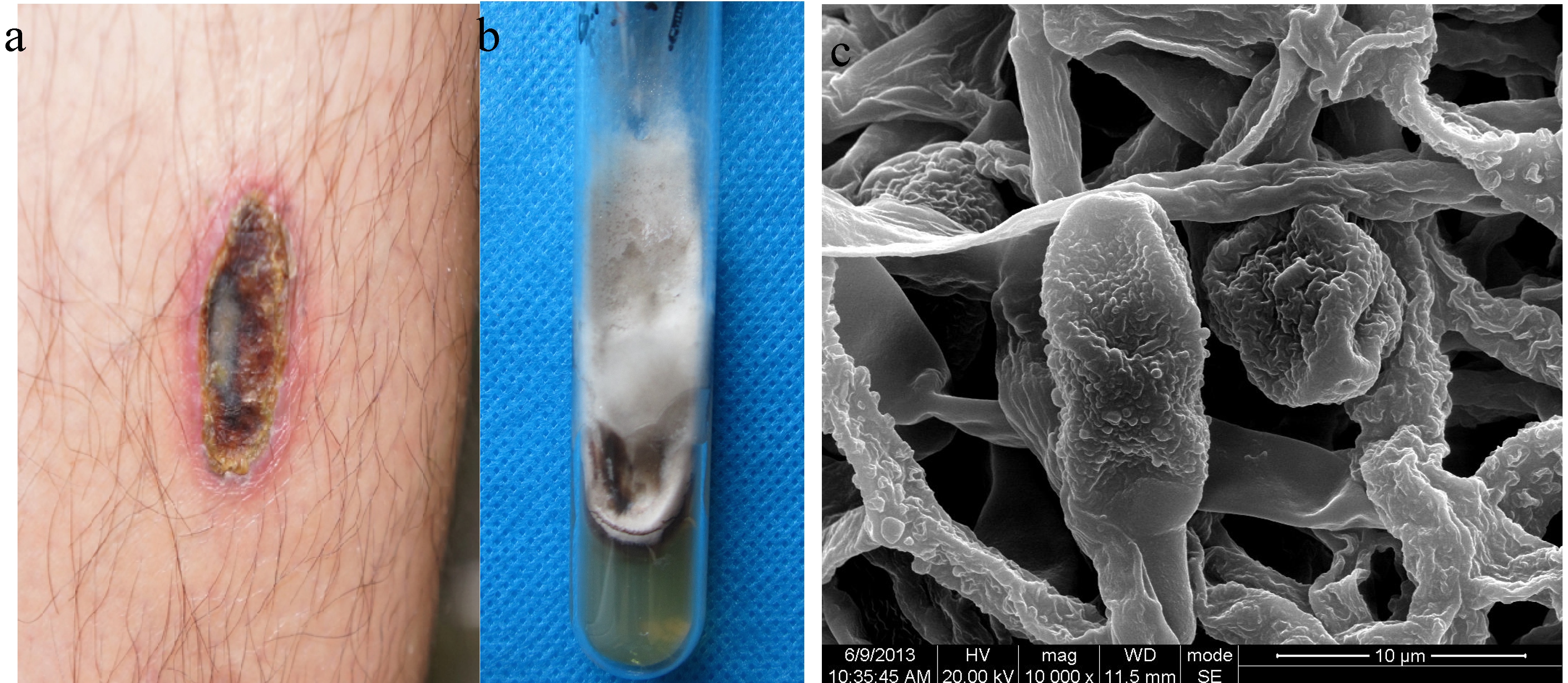|
Blight
Blight is a specific symptom affecting plants in response to infection by a pathogenic organism. Description Blight is a rapid and complete chlorosis, browning, then death of plant tissues such as leaves, branches, twigs, or floral organs. Accordingly, many diseases that primarily exhibit this symptom are called blights. Several notable examples are: * Late blight of potato, caused by the water mold '' Phytophthora infestans'' (Mont.) de Bary, the disease which led to the Great Irish Famine * Southern corn leaf blight, caused by the fungus '' Cochliobolus heterostrophus'' (Drechs.) Drechs, anamorph '' Bipolaris maydis'' (Nisikado & Miyake) Shoemaker, incited a severe loss of corn in the United States in 1970. * Chestnut blight, caused by the fungus ''Cryphonectria parasitica'' (Murrill) Barr, has nearly completely eradicated mature American chestnuts in North America. * Citrus blight, caused by an unknown agent, infects all citrus scions. * Fire blight of pome fruits, ... [...More Info...] [...Related Items...] OR: [Wikipedia] [Google] [Baidu] |
American Chestnut
The American chestnut (''Castanea dentata'') is a large, fast-growing deciduous tree of the Fagaceae, beech family native to eastern North America. As is true of all species in the genus ''Chestnut, Castanea'', the American chestnut produces Bur, burred fruit with edible nuts. The American chestnut was once common in its Appalachian Mountains, Appalachian Mountain range and was a Dominance (ecology), dominant species in the oak-chestnut forest region of its central and southern range. During the early to mid-20th century, American chestnut trees were devastated by chestnut blight, a fungal disease that came from Castanea crenata, Japanese chestnut trees that were introduced into North America from Japan. It is estimated that the blight killed between three and four billion American chestnut trees in the first half of the 20th century, beginning in 1904.Griffin, Gary"Recent advances in research and management of chestnut blight on American chestnut" Phytopathology (journal), Phyto ... [...More Info...] [...Related Items...] OR: [Wikipedia] [Google] [Baidu] |
Phytophthora Infestans
''Phytophthora infestans'' is an oomycete or Oomycete, water mold, a fungus-like microorganism that causes the serious potato and tomato disease known as late blight or potato blight. Early blight, caused by ''Alternaria solani'', is also often called "potato blight". Late blight was a major culprit in the European Potato Failure, 1840s European, the Great Famine (Ireland), 1845–1852 Irish, and the Highland Potato Famine, 1846 Highland potato famines. The organism can also infect some other members of the Solanaceae. The pathogen is favored by moist, cool environments: sporulation is optimal at in water-saturated or nearly saturated environments, and zoospore production is favored at temperatures below . Lesion growth rates are typically optimal at a slightly warmer temperature range of . Etymology The genus name ''Phytophthora'' comes from the Greek (), meaning 'plant' – plus the Greek (), meaning 'decay, ruin, perish'. The species name ''infestans'' is the present partici ... [...More Info...] [...Related Items...] OR: [Wikipedia] [Google] [Baidu] |
Chestnut Blight
The pathogenic fungus ''Cryphonectria parasitica'' (formerly ''Endothia parasitica'') is a member of the Ascomycota (sac fungi). This necrotrophic fungus is native to East Asia and South East Asia and was introduced into Europe and North America in the early 1900s. Strains of the fungus spread more or less rapidly and caused significant tree loss in both regions. Strains of the fungus can be more or less virulent. Overview ''Cryphonectria parasitica'' is a parasitic fungus of chestnut trees. This disease came to be known as chestnut blight. Naturally found in South East Asia, accidental introductions led to invasive populations of ''C. parasitica'' in North America and Europe. In the first half of the 20th century, the fungal disease had a devastating economic and social impact on communities in the eastern United States. It killed an estimated four billion trees; or, by another count, 3.5 billion trees through 2013. Less severe impacts have occurred in Europe due to widespread ... [...More Info...] [...Related Items...] OR: [Wikipedia] [Google] [Baidu] |
Erwinia Amylovora
Fire blight, also written fireblight, is a contagious disease affecting apples, pears, and some other members of the family Rosaceae. It is a serious concern to apple and pear producers. Under optimal conditions, it can destroy an entire orchard in a single growing season. The causal pathogen is ''Erwinia amylovora'', a Gram-negative bacterium in the genus ''Erwinia'', order Enterobacterales. It is a short rod with rounded ends and many peritrichous flagellae. Pears are the most susceptible, but apples, loquat, crabapples, quinces, hawthorn, cotoneaster, ''Pyracantha'', raspberry and some other rosaceous plants are also vulnerable. The disease is believed to be indigenous to North America, from where it spread to most of the rest of the world. Fire blight is not believed to be present in Australia though it might possibly exist there. It has been a major reason for a long-standing embargo on the importation of New Zealand apples to Australia. In Europe it is listed as a quaranti ... [...More Info...] [...Related Items...] OR: [Wikipedia] [Google] [Baidu] |
Citrus Blight
Citrus blight is a type of blight that occurs in tropical and semi-tropical regions. Specializing in infecting citrus trees, the blight is found in North America, the Caribbean, South America, South Africa and Australia. The blight injures plants by forming blockages in xylem and phloem, inhibiting resource distribution and resulting in plant die-back and smaller fruit yields. As of 2020 there is no cure for the blight, and neither the causal agent nor spreading mechanism is known. Description Citrus blight is a type of plant blight. The effects of citrus blight were first documented in the early 20th century. The disease afflicts plants in tropical and subtropical environments; regions impacted by the disease include North America and South America, the Caribbean, South Africa, and Australia. The important citrus-growing regions of California and the Mediterranean have not been affected. The blight spreads through an infected tree, invading and colonizing the plant's roots, l ... [...More Info...] [...Related Items...] OR: [Wikipedia] [Google] [Baidu] |
Great Irish Famine
The Great Famine, also known as the Great Hunger ( ), the Famine and the Irish Potato Famine, was a period of mass starvation and disease in Ireland lasting from 1845 to 1852 that constituted a historical social crisis and had a major impact on Culture of Ireland, Irish society and History of Ireland, history as a whole. The most severely affected areas were in the western and southern parts of Ireland—where the History of the Irish language#Nineteenth and twentieth centuries, Irish language was dominant—hence the period was contemporaneously known in Irish as , which literally translates to "the bad life" and loosely translates to "the hard times". The worst year of the famine was 1847, which became known as "Black '47".Éamon Ó Cuív – the impact and legacy of the Great Irish Famine The population of Ireland on the eve of the famine was about 8.5 million; by 1901, it was just 4.4 million. During the Great Hunger, roughly 1 million people died and more than 1 million m ... [...More Info...] [...Related Items...] OR: [Wikipedia] [Google] [Baidu] |
Alternaria Triticina
''Alternaria triticina'' is a fungal plant pathogen that causes leaf blight on wheat. ''A. triticina'' is responsible for the largest leaf blight issue in wheat and also causes disease in other major cereal grain crops. It was first identified in India in 1962 and still causes significant yield loss to wheat crops on the Indian subcontinent. The disease is caused by a fungal pathogen and causes necrotic leaf lesions and in severe cases shriveling of the leaves. Hosts and symptoms Successful inoculation of ''A. triticina'' has been repeatedly confirmed in ''Triticum turgidum'' subsp. ''Durum'' (durum wheat) and ''Triticum aestivum'' (common wheat, bread wheat) with bread wheat varieties showing more severe infection.Systematic Mycology & Microbiology Laboratory “Alternaria Triticina (Leaf Blight of Wheat).” Invasive Species Compendium, CAB International, 2 Oct. 2019, www.cabi.org/isc/datasheet/4534. Barley, sorghum, triticale, oats, rye, and millet have all been experimentall ... [...More Info...] [...Related Items...] OR: [Wikipedia] [Google] [Baidu] |
Bur Oak Blight
Bur oak blight (BOB) is a fungus, fungal disease that is relatively new to the plant pathogen field. BOB started to appear in Midwestern states in the 1990s. The first few diagnoses pointed to a common fungus, ''Tubakia dryina'', as the culprit. However upon further research BOB was said to be caused by a new unnamed species of ''Tubakia'', later named ''Tubakia iowensis''. BOB has severe symptoms and is a serious new problem. Hosts and symptoms The host for this disease is the bur oak, ''Quercus macrocarpa''. Research shows that ''Q. macrocarpa var. olivaeformis'' tends to be the most susceptible to the pathogen, but the more common and widespread ''Q. macrocarpa var. macrocarpa'' has also been affected by BOB. ''Q. macrocarpa var. olivaeformis'' has a range centered in the state of Iowa and is characterized by acorns that are olive shaped and smaller than the acorns of other susceptible varieties. The range of BOB is centered in the state of Iowa, however, it has also recently b ... [...More Info...] [...Related Items...] OR: [Wikipedia] [Google] [Baidu] |
Alternaria
''Alternaria'' is a genus of Deuteromycetes fungi. All species are known as major Phytopathology, plant pathogens. They are also common allergens in humans, growing indoors and causing hay fever or hypersensitivity reactions that sometimes lead to asthma. They are present in the human mycobiome and readily cause opportunistic infections in immunocompromised people such as AIDS patients. There were about 600 known species in the genus in 2023 (although in 2008 the Dictionary of Fungi only listed 299). They are ubiquitous in the environment and are a natural part of funga almost everywhere. They are normal agents of decay and decomposition. The spores are airborne and found in the soil and water, as well as indoors and on objects. The club-shaped spores are single or form long chains. They can grow thick colonies which are usually green, black, or gray. At least 20% of agriculture, agricultural spoilage is caused by ''Alternaria'' species, with the most severe losses reaching 80% o ... [...More Info...] [...Related Items...] OR: [Wikipedia] [Google] [Baidu] |
Ascochyta
''Ascochyta'' is a genus of ascomycete fungi, containing several species that are pathogenic to plants, particularly cereal crops. The taxonomy of this genus is still incomplete. The genus was first described in 1830 by Marie-Anne Libert, who regarded the spores as minute asci and the cell contents as spherical spores. Numerous revisions to the members of the genus and its description were made for the next several years. Species that are plant pathogenic on cereals include, '' A. hordei'', '' A. graminea'', '' A. sorghi'', '' A. tritici''. Symptoms are usually elliptical spots that are initially chlorotic and later become a necrotic brown. Management includes fungicide applications and sanitation of diseased plant tissue debris. Some of these pathogens in the genus ''Ascochyta'' affect grass species, including grains. Some selected species of ''Ascochyta'' *'' Ascochyta asparagina'', Ascochyta blight *''Ascochyta bohemica'' *''Ascochyta boltshauseri'' *''Ascochyta cari ... [...More Info...] [...Related Items...] OR: [Wikipedia] [Google] [Baidu] |
Water Mold
The Oomycetes (), or Oomycota, form a distinct phylogenetic lineage of fungus-like eukaryotic microorganisms within the Stramenopiles. They are filamentous and heterotrophic, and can reproduce both sexually and asexually. Sexual reproduction of an oospore is the result of contact between hyphae of male antheridia and female oogonia; these spores can overwinter and are known as resting spores. Asexual reproduction involves the formation of chlamydospores and sporangia, producing motile zoospores. Oomycetes occupy both saprophytic and pathogenic lifestyles, and include some of the most notorious pathogens of plants, causing devastating diseases such as late blight of potato and sudden oak death. One oomycete, the mycoparasite '' Pythium oligandrum'', is used for biocontrol, attacking plant pathogenic fungi. The oomycetes are also often referred to as water molds (or water moulds), although the water-preferring nature which led to that name is not true of most species, whic ... [...More Info...] [...Related Items...] OR: [Wikipedia] [Google] [Baidu] |





